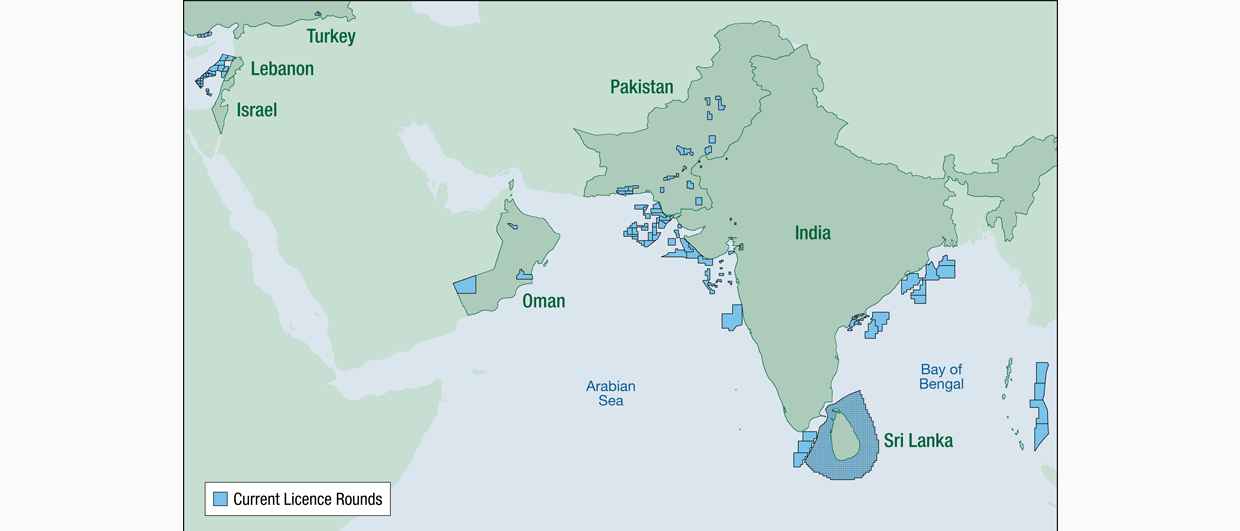As June is drawing to a close, the Middle East and South Asia region have a number of licensing rounds open, with three more offshore rounds anticipated during the year. Such a vast tract of acreage on the table – approximately 560,000 km2 – has surely something to offer to companies still keen for exploration. Cross-border geological data and trends can also be harnessed by reviewing bid rounds in adjacent nations, such as Lebanon and Israel and Pakistan and India.
Levant
In the Eastern Mediterranean, the Levant Basin is a well-established gas province with Early Miocene Nile Delta-derived sandstones characterised by good reservoir properties. Lebanon and Israel are both offering offshore acreage in bid rounds due to close in a couple of days and weeks respectively.
Recently acquired and reprocessed multi-client 2D and 3D seismic data is available to evaluate the acreage, comprising 20 blocks offshore Israel, and eight blocks offshore Lebanon. The pending Qana-1 well to be drilled by TotalEnergies and partners in Lebanon’s southerly Block 9, adjacent to the now ratified maritime boundary with Israel, will no doubt raise interest in the adjacent acreage.
Oman
Moving east, three blocks are on offer onshore Oman until 27th August 2023, with an offshore round scheduled to open later in 2023. Both conventional and unconventional plays may be targeted in Oman’s onshore, a mature petroleum province with good infrastructure and legislative framework. Data can be viewed through an online portal.
While details are not yet released on Oman’s offshore acreage to be offered, this area has been highlighted in recent years with high-quality reprocessed seismic revealing toe thrust structures and DHI-supported targets in the Arabian Sea. ENI are due to drill a second deepwater offshore well later in 2023. The UAE too is expected to offer acreage in various Emirates.
Deeper Cretaceous plays productive in the onshore Lower Indus Basin may nonetheless be viable, and a discovery reported in the data packages for the Saurashtra Basin of India, on trend to the south-east, indicates sub-Deccan plays can have some success.
Sub-Deccan prospectivity in Pakistan
Pakistan is also due to offer offshore acreage in the second half of 2023, with the block outlines already defined. While there has been no significant exploration success in the offshore Indus Basin, it is poorly explored, with the Upper Cretaceous Deccan basalts traditionally viewed as economic basement.
Deeper Cretaceous plays productive in the onshore Lower Indus Basin may nonetheless be viable, and a discovery reported in the data packages for the Saurashtra Basin of India, on trend to the south-east, indicates sub-Deccan plays can have some success.
Not the desired interest
India currently has two bid rounds open, OALP VIII and IX. Repeated extensions to the bid deadline for the OALP VIII indicates that this round has perhaps not generated the desired interest. Reports that international majors such as ExxonMobil and Shell may partner NOCs in emerging basins such as the Andaman, contiguous with the Timpan discovery in offshore Sumatra, could provide a boost to an exploration scene that has been dominated by domestic companies in recent years.
Small countries – big opportunities?
Sri Lanka, meanwhile, has reset its petroleum legislation and block definition in the hope of attracting new investment. The 15 x 15 km graticule system, while allowing the bidder freedom of selection, will need to be carefully managed to ensure bidders receive the running room necessary for a frontier setting.
While not yet announced, Bangladesh intends to open a round this year. With new seismic data in the Bay of Bengal to support it and some interesting well results reported by Gazprom between August 2022 and April 2023, the country should probably attract some interest. However, timing is everything and Bangladesh will have to be careful not to be left behind in encouraging exploration interest and investment.

